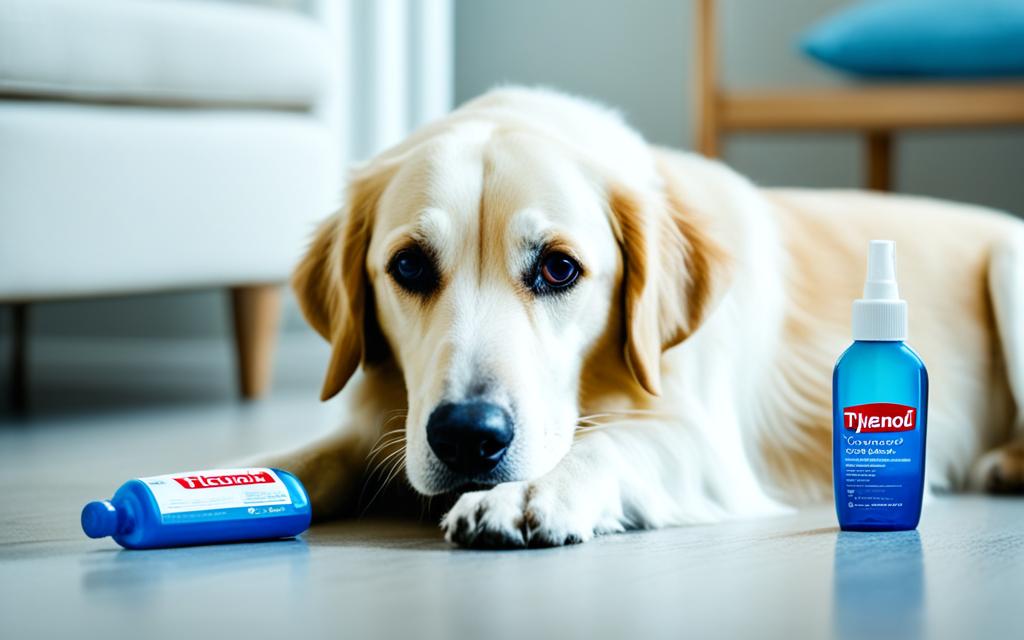Acetaminophen (Tylenol®) for dogs
Many people don’t know that acetaminophen, a common pain and fever medicine for us, is dangerous for dogs. Even though it helps us humans feel better, it can severely harm our furry friends. This danger comes when dogs eat it by accident or when their owners give it to them not knowing the risks. Acetaminophen can make dogs very sick and cause serious health problems.
Dogs who ingest acetaminophen may show signs like feeling down, being weak, and breathing fast. They might also have a quick heart rate, pant a lot, and feel pain in their stomach. Other signs include throwing up, drooling, and changes in their mouth’s color. Using this medicine for a long time can also hurt a dog’s liver and make it hard for their blood to carry oxygen.
This article will dive into how dangerous acetaminophen is for dogs and what to do if they get poisoned. We’ll look at how to use it safely, including the right amount and how often. You’ll learn about its risks and other ways to help your dog feel better without this dangerous medicine. We’ll teach you what you need to know to keep your dog healthy and safe.
Key Takeaways:
- Acetaminophen, a widely used pain relief and fever reducer for humans, can be toxic to dogs.
- Common signs of acetaminophen poisoning in dogs include depression, weakness, rapid breathing, and abdominal pain.
- Acetaminophen can cause liver damage and methemoglobinemia in dogs.
- Treatment for acetaminophen poisoning involves decontamination, activated charcoal, fluids, and, in severe cases, N-acetylcysteine.
- It is crucial to follow up with veterinary care and monitor liver function in dogs who have recovered from acetaminophen poisoning.
Acetaminophen Toxicity in Dogs: Significance and Risks
Acetaminophen poisoning in dogs is a major worry. It can cause liver damage and methemoglobinemia. Dogs, especially young or small ones, are at risk. Knowing the dangers helps dog owners keep their pets safe.
Symptoms of Acetaminophen Toxicity in Dogs
Signs of acetaminophen poisoning can appear in 4-12 hours. It’s key to spot these fast. Main symptoms are:
- Depression and weakness
- Rapid breathing and high heart rate
- Panting and abdominal pain
- Vomiting and drooling
- Changes in mucous membranes
Liver damage might not show up right away. Look out for dark urine and yellow eyes or skin. Also, a big belly, more drinking, and unusual stool color mean urgent vet care is needed.
Importance of Early Decontamination and Treatment
Dealing with acetaminophen poisoning early is crucial. Quick treatment at the vet can save your dog. They might use things like charcoal or induce vomiting to stop the poison’s spread. Fast action is key to preventing worse issues.
Preventing Acetaminophen Poisoning
Preventing poisoning is simpler than treating it. Keep all meds away from pets. Only use medication on your dog if a vet says it’s okay. Keep your pet safe with these simple steps.
Remember, our pets depend on us for their safety. Knowing the risks and acting early can prevent tragedies.
Treatment for Acetaminophen Poisoning in Dogs
Acetaminophen poisoning in dogs requires quick action to protect them. The goal is to limit how much acetaminophen the dog absorbs and to treat the symptoms fast. Veterinarians use several methods to help dogs who have eaten acetaminophen:
- Decontamination: If your dog has recently eaten acetaminophen, vets might try to make them vomit. This can help remove the poison from their body.
- Activated Charcoal: Activated charcoal can be given to your dog. It helps stop the body from absorbing more acetaminophen by binding to it.
- Fluids: Your dog might need to stay in the hospital, especially if they have a serious case. Vets can give them special fluids through a vein or under their skin. This helps keep them hydrated and improves their health.
- N-acetylcysteine: There’s a special medicine called N-acetylcysteine for acetaminophen poisoning. It works by boosting certain chemicals in the liver that help fight the effects of acetaminophen.
Along with these steps, vets could also give your dog other drugs to protect their liver. It’s crucial to keep an eye on your dog after the immediate treatment. This ensures they fully recover and checks for any lasting damage from the poison.
Acetaminophen for Dogs: Dosage and Administration
When it comes to giving dogs acetaminophen, it’s crucial to know the correct dose and how to give it. Always get a veterinarian’s advice first. Using over-the-counter acetaminophen on your own can hurt your pet. It’s because dogs can easily get poisoned.
Acetaminophen dosage: Over-the-counter acetaminophen doesn’t have a set dose for dogs. The right amount depends on the dog’s weight, health, and why they need it. Your vet will tell you how much to give.
Acetaminophen administration: Only give acetaminophen the way your vet says. It might be pills, chewables, or liquid. Always follow the label’s advice or check with your vet.
Frequency and direction of use: How often you give acetaminophen depends on your dog’s issue. Your vet will tell you how to use it. Stick to their plan for the best results.
Missed dose guideline: If you miss a dose, get in touch with your vet right away. Don’t give a double dose without checking with them first. They’ll let you know what to do.
Stick to your vet’s advice on acetaminophen for your dog. They understand your dog’s needs and will make the best plan for them.

| Table 1: Acetaminophen Dosage for Dogs by Weight | |
|---|---|
| Dog Weight Range | Recommended Dosage |
| 10-25 lbs | 5 mg/lb |
| 25-50 lbs | 7.5 mg/lb |
| 50-100 lbs | 10 mg/lb |
| Above 100 lbs | 12.5 mg/lb |
Side Effects and Precautions of Acetaminophen Use in Dogs
Taking care with acetaminophen for dogs is crucial. It can help with pain, but it isn’t risk-free. It’s best to use it under a vet’s advice.
Pregnant dogs and lactating dogs need special care with acetaminophen. Avoid giving it to these dogs without a vet’s ok. It could harm their babies. If your dog is pregnant or nursing, talk to your vet first.
Acetaminophen is usually safe for dogs if used right. But, dogs might get sick or have liver problems. Watch for signs like not eating, yellow skin, or hard breathing. Get help from a vet right away if you see these signs.
Always talk to your vet before giving acetaminophen to your dog. Your vet will tell you the right amount and times to give it. They’ll also help you watch for any problems that might come up.
Using acetaminophen in dogs needs caution, vet’s advice, and your watchful eye. If you’re mindful of the risks and care for these details, your dog can safely receive this medication.
Table: Summary of Side Effects and Precautions of Acetaminophen Use in Dogs
| Side Effects | Precautions |
|---|---|
| Gastrointestinal upset (vomiting, diarrhea) | Avoid use in pregnant and lactating dogs |
| Liver damage (high doses, underlying liver disease) | Monitor for signs of toxicity |
| Consult a veterinarian for dosage and administration guidelines |
Comparison of Acetaminophen with Other Pain Relief Medications for Dogs
Acetaminophen is not usually suggested for dogs because it can be harmful. There are safer options made just for animals. These work better and are safer for our pets than acetaminophen.
Cost, effectiveness, and side effects are important when picking a pain relief drug. We will see how acetaminophen does against the usual choices for dogs’ pain.
Efficacy
Pain drugs for dogs aim to make them feel better and live well. While acetaminophen might help a bit, other drugs do a better job. These are made just for animals, so they are safe and work well for our pets.
Cost
Thinking about cost, we need to consider both up-front and ongoing expenses. Acetaminophen might look cheaper at first. But, its risks and how well it works might cost you more later on. Talk to your vet to find out what’s both affordable and safe for your dog.
Side Effects
One big thing to think about is acetaminophen’s bad effects. It can harm dogs’ livers and cause other health problems. But, medicines made for dogs have gone through tests. They are safe and don’t cause as many issues.
So, while acetaminophen is okay for us, it’s risky for dogs. There are better, safer choices out there for pets. Always talk to your vet to find the best option for your dog.
Essential Information about Acetaminophen for Dogs
Acetaminophen, sold under the brand name Tylenol®, helps reduce pain and fever in people. Sometimes, vets may suggest it for dogs, but it’s important to check with them first. It comes in different types like tablets, liquid, and shots.
Acetaminophen isn’t OK’d by the FDA for dog use. So, you must talk to your vet first if you’re thinking about giving it to your pet. They’ll know how much to use and how to do it safely for your dog’s unique situation.
Using acetaminophen with dogs requires a lot of caution. Giving it without your vet’s advice could be very dangerous. To avoid harm, always get your vet’s approval for the right dose and the best way to use it.
Watch out for side effects when your dog is on acetaminophen. They might include liver issues, tummy problems, and problems with blood. Keep an eye on your pet for any signs that something’s not right while they’re using this drug.
Remember, just because it’s easy to buy acetaminophen for yourself, doesn’t mean it’s safe for your dog. It’s a must to talk with your vet first about using it. They can guide you on how to use it safely for your dog and warn you about any risks.
Benefits of Acetaminophen for Dogs
Acetaminophen, often called Tylenol®, helps dogs under careful vet use. It’s good for easing pain and reducing fever, which are important for many dog illnesses.
Pain relief: Tylenol® can make dogs feel better when they have mild to moderate pain. It works on how the body feels pain, which can boost a dog’s mood and health.
Fever reduction: This medicine can also lower a dog’s fever. Fevers can show something is wrong, so by dropping the temperature, acetaminophen can help healing.
But, using acetaminophen has its risks. It’s important to use it carefully and in the right amount. Only a vet should decide the dose, making sure it’s safe and helpful for the dog.
Always talk to a vet before giving your dog acetaminophen. They will check if it’s a good idea and how to use it correctly. This step is key to keep your dog safe and get the best results.
We’re going to cover how to safely give your dog acetaminophen next. The focus is on keeping your furry friend healthy and happy during treatment.
Administering Acetaminophen to Dogs: Guidelines and Considerations
Giving acetaminophen to dogs is tricky and needs special care. Always talk to a vet first to keep your pet safe.
The right amount of acetaminophen depends on your dog’s weight and health. A vet will tell you how much to give and how often. It’s important to listen closely and not give more than they say.
How often you give acetaminophen is also up to the vet. Never give it to your dog more than told, to prevent problems.
Make sure you understand how to give acetaminophen. It can be in tablets or liquid, and the label will guide you.
Keep to the schedule your vet gives you. If you miss a dose, don’t make it up yourself. Call your vet for advice on what to do.
Key Guidelines for Administering Acetaminophen to Dogs:
- Consult with a veterinarian before administering acetaminophen.
- Follow the prescribed dosage based on the dog’s weight and condition.
- Adhere to the recommended frequency of administration.
- Read and follow the provided directions carefully.
- Contact the vet if a dose is missed.
Always give acetaminophen to dogs under the guidance of a vet. By listening to your vet’s advice, you help ensure your dog’s safety.
Potential Side Effects and Precautions of Acetaminophen in Dogs
Acetaminophen helps dogs by relieving pain and discomfort. But, it has some risks, too. It’s important to know the possible side effects and take the right precautions. This keeps your dog safe.
Possible Side Effects of Acetaminophen
Acetaminophen can cause issues from mild to severe in dogs. Some dogs are more sensitive to it. After giving acetaminophen, watch your dog closely for any bad reactions. Signs might include:
- Vomiting or diarrhea
- Lethargy or weakness
- Loss of appetite
- Itching or hives
Seeing any of these signs means you should talk to your vet. They might suggest changing the dose or stopping acetaminophen use.
Precautions to Consider
Pregnant and nursing dogs need extra care with acetaminophen. Always ask your vet before giving it to them. Acetaminophen could affect the mother dog and her puppies.
Dogs with liver or kidney problems should not take acetaminophen. It can make these issues worse.
Monitoring for Adverse Reactions
When your dog is on acetaminophen, keep an eye out for bad reactions. Signs of a problem include:
- Difficulty breathing
- Irregular heartbeat
- Pale gums
- Jaundice (yellowing of the skin or eyes)
Seeing these symptoms or any unusual behavior means you should get to the vet right away.
Always work closely with your vet when using acetaminophen. They’ll give advice tailored to your dog’s health. Talking openly about your concerns is key to keeping your dog safe.
Conclusion
Using acetaminophen for dogs needs careful thought. Always do this under a vet’s guidance. It helps with pain and lowers fever. But, if not used right, it can be harmful. Hence, following the correct dose and method is key for safety.
Vets are crucial in advising dog owners on acetaminophen use. They offer insights tailored to your dog’s needs. This guidance makes sure using acetaminophen is both safe and helpful.
When used properly, acetaminophen is a helpful pain and fever management tool for dogs. Yet, it’s vital to consider both the good and bad. Always talk to a vet before giving acetaminophen to your dog. This is to keep them safe and well.







